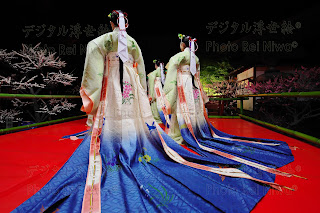テーマ「日本の無形文化財における芸術性」について About the theme “Artistry in Japanese Intangible Cultural Properties”
テーマ「日本の無形文化財における芸術性」について
 |
| 麗しき春宵(天満天神うめ祭: 大阪天満宮) Beautiful spring night (Temma Tenjin Ume Festival: Osaka Tenmangu Shrine) |
*以下、文章に個人的な意見・見解を含みます
私たちが住んでいる日本列島の地形は起伏に富み、火山地、丘陵を含む山地の面積は国土の約67%を占めています(2017年3月現在)。山地は谷によって細かく刻まれ、斜面は一般に急傾斜で、大部分は森林に覆われています。
様々な説や考え方が存在していますが、その自然環境の中で生活してきた日本人が自然環境を畏れ敬うかたちで生まれてきたものが神道といわれています。
神道は日本特有の宗教であり、キリスト教のイエス、イスラム教のムハンマド、仏教の釈迦のような教祖や開祖が神道にはいませんし、『聖書』や『コーラン』『法華経』などの経典もありません。
 |
| 風流武者行事(御田植神事: 住吉大社) Elegant Samurai dance (Rice Planting Shinto Ritual: Sumiyoshi Taisha Shrine) |
私は毎年様々な神社で行われている神事や祭りの記録撮影を行っています。一部では神饌の用意を含めて準備から参加させていただいています。私個人として、この神道を表現するものとして発展して継承されてきたものが無形文化財である祭りと思います。特に御祭神である自然環境や神社に関する逸話を歌舞音曲、衣装、所作 等で表現している芸術=無形文化財といえます。
 |
| 舞楽奉納(観月祭: 住吉大社) Kagura Dance in Harvest Moon Shinto Ritual (Sumiyoshi Taisha Shrine) |
無形文化財について、文化庁によれば(以下引用)~演劇,音楽,工芸技術,その他の無形の文化的所産で我が国にとって歴史上または芸術上価値の高いものを「無形文化財」という。~(以下略)とあり解釈として一致していると思います。
私は日本の伝統文化である祭りを撮影することで、無形文化財における芸術性を表現しています。
*この記事をお読みになって、協賛金をお支払いくださる方は下記ボタンからお願いします。
取材や作品制作に使わせていただきます。
掲載記事の更新日2025年03月10日
About
the theme “Artistry in Japanese Intangible Cultural Properties”
 |
| 神田代舞の奉納(御田植神事: 住吉大社) Mitoshiro dance is offered (Rice Planting Shinto Ritual: Sumiyoshi Taisha Shrine) |
*Articles
contain personal opinions
The
Japanese archipelago, where we live, has an undulating topography, and
mountains, including volcanic areas and hills, occupy about 67% of the country
(at March 31 2017). The mountain which was chopped in a valley and the slopes
are generally steep and largely forested.
There
are various statements and interpretations, but it is said that Shinto was born
in the form of awe and respect for the natural environment by the Japanese who
have lived in the Japanese natural environment.
Shinto
is a religion peculiar to Japan, and there are no founders like Jesus of
Christianity, Muhammad of Islam, or Shakyamuni of Buddhism in Shinto. And there
are no scriptures such as the Bible, the Koran, or the Lotus Sutra.
 |
| 船渡御(天神祭: 大阪天満宮) Funatogyo Ritual (Tenjin Festival: Osaka Tenmangu Shrine) |
Every
year I photograph to record the Shinto rituals and festivals held at various
shrines. In some cases, I sometime participate from the preparation stage,
including the preparation of the Shinsen (=Offering for Shinto god). Personally,
I think that festivals are intangible cultural assets that have developed and
been handed down as expressions of Shintoism. In particular, the art that
expresses about the natural environments that are an enshrined deity, and the
anecdotes of shrine, that are enshrined with songs, costumes, movements, etc.
can be said to be an intangible cultural asset.
 |
| 御神楽舞(一夜官女祭: 野里住吉神社) Expelling evil spirits (Ichiya Kanjo Festival: Nozato Sumiyoshi Jinja Shrine) |
According
to the Japanese Agency for Cultural Affairs (quoted below), "intangible
cultural properties" are theater, music, crafts, and others that are of
high historical or artistic value to Japan ~ (omitted below). I think that is
consistent my interpretation of Japanese Shinto Rituals and Festivals.
I
express the artistry in Japanese
intangible cultural properties by photographing traditional Japanese
festivals.
*If you would like to pay a monetary contribution after reading this article, please click the button below.
I will use it for expense for covering news and making artworks.
This page was last modified: January 16, 2023


写真ありがとうございます。神事や宗教行事 と 神社のお金や人寄せが 気になります。
返信削除魚住玄通様コメントありがとうございます。
削除さて、私がきいたところでは、今回の旧統一教会関係が社会問題化するかなり前から、神社庁系の神社を中心に様々なことに気を使っています。
個人的には神道を含めてもっと宗教の中身の説明をして理解をしてもらった方がいいと思っています。
私の記録撮影はそうした意味も込めて行っています。